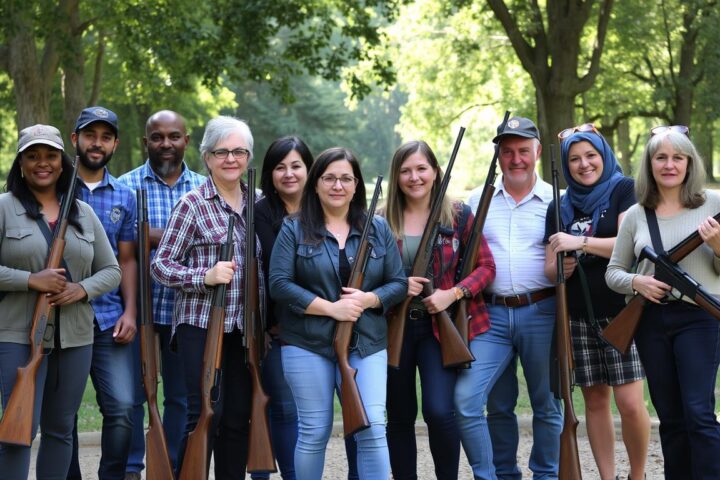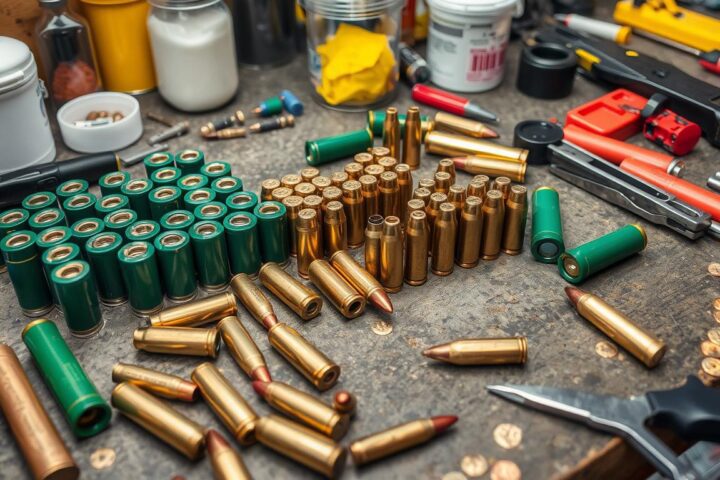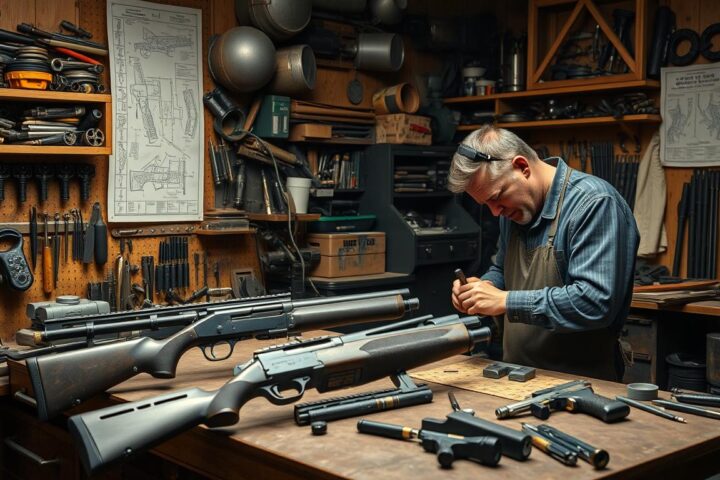Did you know that about 5 to 10 million AR-15 rifles are owned by Americans? This shows how big an impact the AR-15 has had on our gun culture. It went from a military tool to a common household item. Exploring the AR-15 history shows how it changed the military rifle scene and sparked debates on gun rights and safety.
The AR-15 was made for the military but has become more than that. It’s a symbol of both progress and controversy. We’ll look at key events and people that shaped its story. From its beginnings to today, we’ll see how it reflects American gun evolution, laws, and how we view firearms.
The Birth of the AR-15: A Revolutionary Design
The AR-15’s creation is a key moment in firearm history. It came from Eugene Stoner’s innovative ideas at ArmaLite. His work on the AR-10 design set the stage for a new era of rifles. These rifles changed the game for both military and civilian use.
The Visionary: Eugene Stoner and the AR-10
Eugene Stoner was a genius behind the AR-10. This rifle was made with aluminum and fiberglass, which was new and innovative. It marked a shift towards modern rifle design. Stoner focused on making a rifle that was not only functional but also adaptable.
The Development of the AR-15
The AR-15 came from the need for a more efficient military rifle. The military wanted a rifle that could use smaller, high-velocity cartridges like the .223 Remington. The AR-15 took the best parts of the AR-10 and improved upon them. By 1963, the AR-15 was already in high demand, with orders from the Army and Air Force.
This shows how quickly it was accepted. For more on the AR-15’s role in American culture, check out this link.
The Military’s Need for a New Rifle
The evolution of military firearms has often reflected the changing needs of warfare. The move from the M1 Garand to the M14 rifle was a big step forward. It showed the U.S. military’s focus on making weapons that are lighter and fire faster to support soldiers better.
Transition from the M1 Garand to the M14
The M1 Garand was a key rifle used in World War II. But it became outdated for the new tactics of the Korean War and later. The M14 was a big improvement, offering better ergonomics and firepower for modern battles.
The NATO Influence on Rifle Design
NATO’s push for standardization changed how military firearms were made. They wanted all countries to use the same weapons for better cooperation. This led to the M14 rifle, which helped unite military strategies. It also led to the AR-15, a rifle known for its reliability and flexibility in combat.
My thoughts on the ongoingdebate about gun ownership show how military firearms have shaped American culture.
The AR-15 in the 1960s: From Prototype to Military Service
The 1960s were key for the AR-15, moving from prototypes to military use as the M16 rifle. American forces needed a light, adaptable weapon for various combat situations. This need was crucial.
Trials and Military Adoption as the M16
The AR-15 went through tough military tests before being accepted. At first, it didn’t meet U.S. Army standards in 1958, leading to the M14 rifle. But, changes made the AR-15 into the XM16E1. By November 1964, the U.S. Secretary of Defense approved big orders for the XM16E1 and M16 rifles, starting its military use.
By 1961, the U.S. military ordered thousands of these rifles for their light weight. General Curtis LeMay’s orders sent the AR-15 to special forces in South Vietnam. The M16, coming from the AR-15, became key in American combat plans.
The Vietnam War Impact on AR-15’s Popularity
The Vietnam War boosted the AR-15’s popularity by testing it in real combat. Soldiers and advisors praised its accuracy and fire rate in close fights. These trials made it a standard weapon.
The war showed the AR-15’s tactical benefits, making it well-known. Early issues were fixed, leading to the M16A1 standard in 1967. This change cemented the AR-15’s place in the U.S. military and its role as a frontline weapon. This story helps us understand today’s debates on the Second Amendment.
The Patent and Trademark: Colt’s Role in AR-15 History
The Colt AR-15’s story is closely linked with major events in the gun world. In 1959, ArmaLite sold the patents and trademarks for the AR-15 to Colt’s Manufacturing Company. This move helped the Colt AR-15 become a big name in civilian markets.
Bidding Farewell: Armalite’s Sale to Colt in 1959
This sale changed the AR-15’s future. Colt wanted to make the most of the growing interest in semi-automatic rifles. They introduced the Colt AR-15 Sporter in 1964, making it popular with both civilians and law enforcement. It was great for hunting and target shooting, catching the eye of many in the firearms world.
Commercial Success of the Colt AR-15
At first, the AR-15 didn’t catch on quickly. But, with smart marketing, it became known as “America’s rifle.” It appealed to people for its many uses, like in youth sports and by police. As sales went up, Colt became a leader, leading to many other versions and copies after its patent ended in the 1970s. This let other companies make their own versions, giving buyers more choices.
The Colt AR-15 has seen ups and downs over the years, facing political issues and changing tastes. Knowing its history sheds light on today’s debates over gun laws. For more on the current discussions about gun rights and laws, check out this insightful article.
The Evolution of the AR-15: Market Dynamics and Consumer Interest
The firearm market has changed a lot since 1977 when AR-15 patents expired. This event led to many new AR-15-style rifles being made. The term “modern sporting rifle” became popular, changing how people saw these guns.
The Expiration of Patents: A New Era of Imitation
After AR-15 patents ended, many more options became available for those wanting the commercial AR-15. This led to a wide range of models from different manufacturers. People started to see the value in customizable and versatile rifles, making the AR-15 even more popular.
Introduction of Modern Sporting Rifle Terminology
Calling AR-15-style rifles “modern sporting rifles” helped them appeal to more people. This name avoided the negative feelings linked to “assault weapons.” It helped manufacturers reach out to those looking for versatile guns. This change helped the AR-15 gain more acceptance and meet the needs of today’s gun owners.
For more info on firearms and their impact, check out this insightful resource.
The AR-15’s Infamy: High-Profile Incidents and Their Impact
The AR-15 is known for its role in some of America’s most tragic events. After high-profile incidents, people’s views on this rifle changed a lot. The gun industry and groups that support it are now talking more about gun violence and how to control it.
Mass Shootings and Public Perception
The Sandy Hook School shooting started a big talk about gun control. Now, many see the AR-15 as linked to mass killings. This has led to more calls for stricter gun laws. People are debating how to stop these tragedies and what role the AR-15 plays in them.
The Firearm Industry’s Response to Controversy
The gun industry is trying to show that the AR-15 is used for safe and legal activities like sports and protecting oneself. Yet, the negative views on AR-15s in mass shootings still exist. Groups are working to change the conversation to focus on safe gun ownership and public safety. I suggest looking into responsible gun use, like choosing strong holsters for carrying your gun safely here.
Gun Rights, Gun Laws, and the AR-15
The debate over gun rights and laws for the AR-15 is intense in America. People have strong feelings about the Second Amendment and its impact on gun laws. Some believe everyone should be able to own guns without too many rules. Others think we need stricter laws to reduce violence.
The Second Amendment: Context and Significance
The Second Amendment is about the right to bear arms, but its meaning is still up for debate. Some see it as a way to protect against government abuse. Others worry it leads to too many guns and violence. The argument is about finding a balance between personal freedom and public safety.
Current Gun Laws Affecting AR-15 Ownership
AR-15 laws vary by state, creating a mix of rules for owning, buying, and using these guns. These laws include checks, waiting periods, and limits on magazine size. Cities struggle to control crime while respecting the Second Amendment. Despite federal calls for limits, many banned weapons aren’t registered. The link between guns and safety is clear, especially with semi-automatics making up a big part of gun ownership. Studies suggest universal background checks could cut down on gun deaths. You can learn more about this debate here.
Customization and Modularity: The Allure of AR-15 Style Rifles
The AR-15 rifle is known for its wide range of customization options and modular design. As a gun owner, I find it fascinating how the rifle can be tailored to fit my needs and preferences. This flexibility has led to a thriving market for aftermarket parts and accessories, enriching the AR-15 community.
Aftermarket Parts and Accessories
The AR-15 customization market has grown significantly, offering many ways to personalize your rifle. These aftermarket parts improve performance and look, making owning an AR-15 a unique experience. Key areas for customization include:
- Trigger upgrades to improve accuracy and responsiveness.
- Barrel modifications that can adjust caliber and length for different situations.
- Optics and sights tailored to individual preferences for quick target acquisition.
- Adjustable stocks and grips for better fit and comfort.
This wide range of aftermarket options ensures the AR-15 can meet various needs. Whether for home defense, competitive shooting, or just for fun, the rifle can be customized to fit.
The AR-15’s Appeal to Gun Enthusiasts
The AR-15’s modular design has made it popular among gun enthusiasts, especially women. There’s a growing number of female shooters who appreciate the rifle’s reliability and versatility. This trend is seen in competitive shooting sports, where the AR-15 is a top choice.
- Instructors offering training programs to empower women and improve their skills.
- Female-focused communities providing support and shared experiences.
- Manufacturers creating products that cater to women’s interests in firearms.
With more women joining, the AR-15 is breaking down stereotypes, promoting empowerment, and building community. The ongoing interest in customizing the AR-15 shows its strong position in American gun culture.
Future Trends: What Lies Ahead for the AR-15
The world of firearms is always changing, especially for the AR-15. New tech is making it better and more popular. We’ll see smart gun features, safer designs, and stronger materials. These changes show how important it is for makers and buyers to stay flexible.
Evolving Technologies in Firearm Design
Now, AR-15s are getting high-tech upgrades. These make them work better and meet what people want. Things like biometric locks and comms systems are becoming common. This makes the AR-15 more appealing to a wider range of users, from hobbyists to experts.
Changing Public Sentiment and Regulatory Outlook
Views on guns are changing, with more talk about safety and responsibility. This leads to new rules that could affect the AR-15. It’s important to watch how laws might change and what that means for gun owners. As people think more about safety and rights, they might look for AR-15s that are both useful and accepted.
The mix of new tech and changing views will shape the AR-15’s future. I’m interested in how these things will influence gun ownership and the AR-15’s role in American life. The future will bring both new tech and challenges, and keeping up with the news is key for gun lovers.
For those into tech, check out the Baofeng UV-5R 8W Ham Radio Full. It shows how tech is improving, just like in the gun world.
The Broader Context of Firearm Ownership in America
Firearm ownership in the United States is complex, with the AR-15 at its heart. This rifle means more than just a tool; it’s a symbol of freedom for many. Exploring the AR-15 shows how firearms are linked to rights, duties, and worries about gun violence.
Cultural Significance of the AR-15
The AR-15 is a key part of American firearms culture. With over 250 million privately owned guns, many people buy them for self-defense. The rifle’s ability to be customized attracts both hobbyists and those looking for safety.
Studies show firearms are used defensively about 2.5 million times a year, more than in crimes. This shows many see the AR-15 as vital for protecting themselves in a dangerous world.
Gun Ownership Trends and Self-Defense Concerns
Looking into gun ownership trends, self-defense is a top concern. Data shows 2,575 lives are saved for every life lost to a gun. This shows the complex views on gun rights.
Gun rights groups push for freedom, but lawmakers want stricter laws. The accidental gun death rate is low, but there’s still debate on public safety and rights. The AR-15 is at the center of this debate, balancing cultural importance and legal scrutiny.















